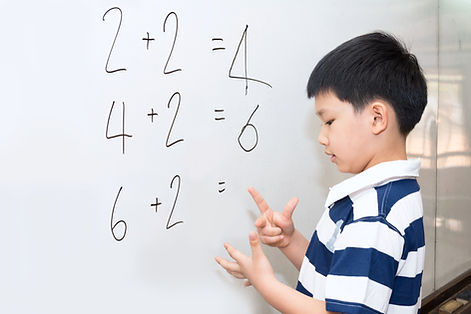
Kindergarten Mathematics
Welcome to Kindergarten Mathematics! This is an exciting time for young learners to explore numbers, shapes, and patterns. Our goal is to make math fun and engaging, helping children build a strong foundation for their future learning. Let's embark on this journey together, where curiosity and creativity go hand in hand with mathematical discovery!
Counting and Cardinality (Weeks 1–8)
Learning Objectives
- Count to 100 by ones and by tens.
- Count forward beginning from a given number within the known sequence.
- Write numbers from 0 to 20.
- Understand the relationship between numbers and quantities.
Content Standards (MCCRS)
- K.CC.1: Count to 100 by ones and by tens.
- K.CC.2: Count forward beginning from a given number within the known sequence.
- K.CC.3: Write numbers from 0 to 20.
- K.CC.4: Understand the relationship between numbers and quantities.
Instructional Strategies
- Daily number songs and chants.
- Hands-on counting with manipulatives (cubes, counters).
- Number writing practice using tracing sheets.
- Interactive digital number games.
Assessment Methods
- Oral counting checks.
- Written number formation assessments.
- Matching quantities to numerals tasks.
- Teacher observations during math centers.

Operations and Algebraic Thinking (Weeks 9–16)
Learning Objectives
- Understand addition as putting together and adding to, and understand subtraction as taking apart and taking from.
- Represent addition and subtraction with objects, fingers, mental images, drawings, sounds, acting out situations, verbal explanations, expressions, or equations.
- Solve addition and subtraction word problems within 10.
Content Standards (MCCRS)
- K.OA.1: Represent addition and subtraction with objects, fingers, mental images, drawings, sounds, acting out situations, verbal explanations, expressions, or equations.
- K.OA.2: Solve addition and subtraction word problems, and add and subtract within 10.
Instructional Strategies
- Use of manipulatives and story problems to explore addition and subtraction.
- Math journaling to draw and explain thinking.
- Songs and finger plays to model operations.
- Group work using real-world scenarios.
Assessment Methods
- Performance tasks involving manipulatives.
- Observation of verbal and visual explanations.
- Mini-assessments with visual prompts.
- Student reflections in math journals.

Numbers and Operations in Base Ten (Weeks 17–24)
Learning Objectives
- Compose and decompose numbers from 11 to 19 into ten ones and some further ones.
- Use objects or drawings, and record each composition or decomposition by a drawing or equation.
Content Standards (MCCRS)
- K.NBT.1: Compose and decompose numbers from 11 to 19 into ten ones and some further ones using objects or drawings.
Instructional Strategies
- Place value games using base ten blocks.
- Decomposing number mats and graphic organizers.
- Small group work building numbers with manipulatives.
- Digital tools to visualize number structure.
Assessment Methods
- Hands-on math station tasks with recording sheets.
- Exit tickets showing decomposition using drawings.
- Verbal explanations during guided math.
- Performance-based rubrics.

Measurement and Data / Geometry (Weeks 25–32)
Learning Objectives
- Describe measurable attributes of objects, such as length or weight.
- Classify objects into given categories and count the numbers of objects in each category.
- Identify and describe shapes (squares, circles, triangles, rectangles, hexagons, cubes, cones, cylinders, and spheres).
Content Standards (MCCRS)
- K.MD.1: Describe measurable attributes of objects.
- K.MD.3: Classify objects into categories; count the numbers of objects in each category.
- K.G.1: Describe objects in the environment using names of shapes.
- K.G.3: Identify shapes as two-dimensional or three-dimensional.
Instructional Strategies
- Shape hunts and measurement scavenger hunts.
- Hands-on comparisons using balance scales, rulers, etc.
- Sorting and classifying objects by attributes.
- Shape construction with tangrams and modeling clay.
Assessment Methods
- Sorting and labeling tasks.
- Classifying graphic organizers.
- Shape identification games.
- Oral questioning and observation logs.